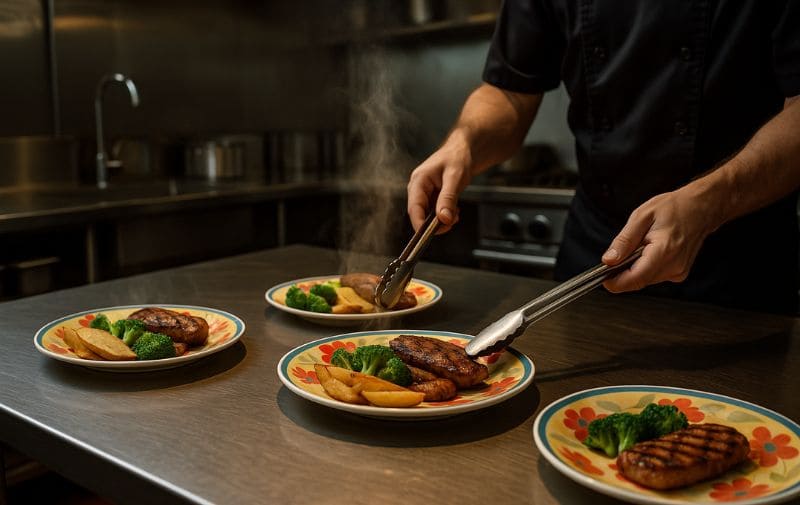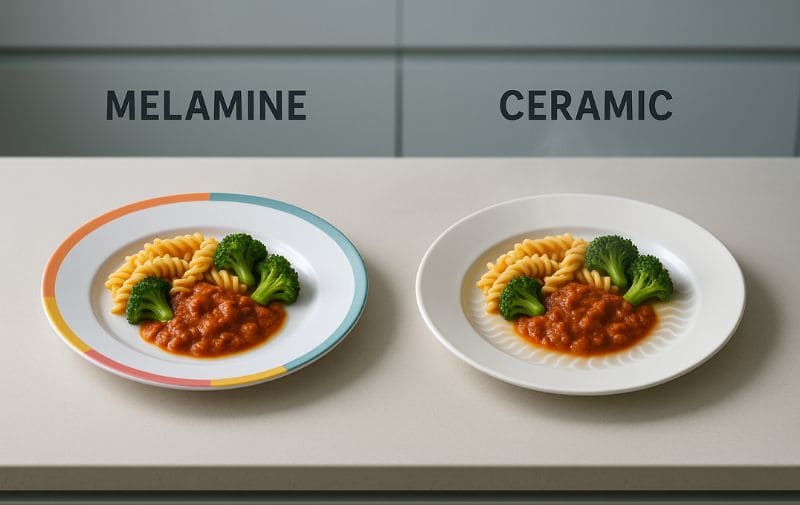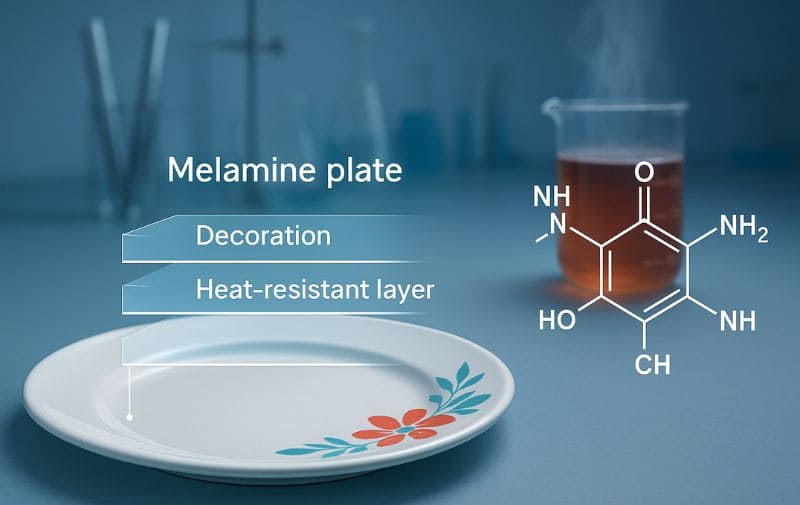You’re serving a hot meal and reach for a plate. You love your melamine dinnerware, but a nagging question pops into your head: is it actually safe for hot food? You’ve heard stories about plastics and heat, leaving you unsure.
Yes, you can absolutely put hot food on high-quality melamine plates. They are specifically designed to handle the heat of freshly cooked meals. The one unbreakable rule is to never put melamine plates in the microwave or oven.
That simple “yes” comes with some very important science behind it. As someone who has worked with this material for decades, I want to clear up the confusion once and for all. The safety of melamine isn’t just about a temperature number; it’s about understanding how the material is made and how it behaves with different types of heat. Let’s dive into what makes melamine safe for your hot soup and steak, and why the microwave is its one true enemy.
Last Updated: July 7th. 2025 | Estimated Reading Time: 15 Minutes

How Are Melamine Plates Designed to Handle Heat Safely?
Worried that your steamy pasta might be too hot for your plate? You can relax. The science behind melamine manufacturing makes it uniquely suited for the job.
High-quality melamine is engineered to easily withstand temperatures of boiling water (100°C / 212°F). This is because it’s a “thermosetting plastic,” meaning its molecular structure is permanently locked in place during production, making it stable and inert when holding hot food.
To really understand this, we need to look at what separates melamine from other plastics. It all comes down to a key manufacturing process.
What “Thermosetting Plastic” Means for Safety
Melamine is what we call a thermoset. During the manufacturing process, melamine resin powder is subjected to immense heat and pressure. This triggers an irreversible chemical reaction, much like baking a cake. Once the flour, eggs, and sugar are baked into a cake, you can’t turn it back into batter.
Similarly, the melamine molecules form strong, permanent, cross-linked bonds, creating a hard and durable structure. This “curing” process locks the molecules in place, which is why the plate won’t warp or leach chemicals when it comes into contact with your hot dinner.
| Plastic Type | Behavior Under Heat | Molecular Structure | Safety for Hot Food | Example |
|---|---|---|---|---|
| Thermoset Plastic | Cures into a permanent, rigid shape. Does not remelt. | Cross-linked, locked in place. | Excellent. Designed for this purpose. | Melamine Plates |
| Thermoplastic | Melts and can be reshaped when heated. | Long chains that can slide past each other. | Varies greatly. Can warp or melt. | Plastic food containers |
The Boiling Water Standard
The industry benchmark for heat resistance in quality melamine is its ability to handle boiling water. This means any food coming fresh off the grill, out of a pot, or from a serving pan is well within the plate’s safe operating temperature. Most high-quality plates are rated for continuous use with food up to 160-180°F (70-82°C), with the ability to handle the short-term, higher temperatures of freshly served food without any issue.
The Hidden Benefit: Why Melamine is Safer for Servers and Children?
Have you ever tried to pick up a ceramic plate filled with hot soup? You probably needed an oven mitt. Melamine has a secret safety feature that solves this problem.
Melamine is a very poor conductor of heat. Unlike ceramic or glass, the heat from the food stays in the food and does not transfer to the plate itself. The bottom of the plate remains cool enough to handle safely.
This is one of the most underrated properties of melamine and a massive advantage in both homes and professional kitchens.
Insider Insight: When you pour hot soup into a ceramic bowl, the bowl itself can become dangerously hot. Melamine doesn’t do this. The heat stays in the food, while the bottom and sides of the plate remain cool enough to handle. This is a massive safety advantage in commercial kitchens, allowing servers to carry plates without getting burned. It’s also a crucial feature for children’s dinnerware, protecting little hands from the heat of the food.

An Insulator, Not a Conductor
Think of your plate as a coffee thermos. The thermos keeps your coffee hot but the outside stays cool. Melamine works in a similar way. This low thermal conductivity is a game-changer for safety and convenience. In a busy restaurant, servers can carry plates of steaming hot food without burning their hands, which improves efficiency and reduces accidents.
At home, it’s a crucial safety feature for children’s dinnerware. You can serve a child warm food without worrying that they will burn their hands by touching the outside of the bowl or plate. This simple property makes the dining experience safer and more comfortable for everyone.
| Material | Heat Conductivity | Experience with Hot Food | Best For |
|---|---|---|---|
| Melamine | Very Low | Plate stays cool to the touch. | Serving, families, restaurants. |
| Ceramic/Porcelain | High | Plate becomes very hot, difficult to handle. | Aesthetic dining, requires caution. |
| Glass | High | Plate becomes very hot, can shatter with thermal shock. | Specific culinary uses |
The Critical Distinction: Hot Food vs. Hot Objects?
This is the most important safety rule that 90% of people misunderstand. Just because a plate can handle hot food doesn’t mean it can handle any hot object.
Serving hot food from a pot is perfectly safe. Placing the hot pot on the plate is not. Direct contact with a hot pan or a dish from the oven will scorch, burn, and permanently damage the melamine.
The type of heat transfer is what matters here. Your food delivers convective heat, which is distributed and well within the plate’s limits. A metal pan coming off a 400°F (200°C) stove, however, delivers intense, focused conductive heat that will destroy the plate’s surface.
The Do’s and Don’ts of Heat and Melamine
To keep it simple, here is a clear guide:
- DO pour boiling soup directly into a melamine bowl.
- DO serve a fresh-off-the-grill steak or chicken breast on a melamine plate.
- DO load up a plate with steamy pasta and sauce.
- DO NOT use a melamine plate as a spoon rest next to a hot stove.
- DO NOT take a baking dish out of the oven and place it on a melamine serving platter.
- DO NOT use a melamine plate to carry a hot pot from the stove to the table.

Following this simple rule will protect your plates and ensure they last for years.
| Action | Is it Safe? | Why? |
|---|---|---|
| Serving boiling soup (100°C / 212°F) | Yes | The plate is designed to handle food temperatures well above serving heat. |
| Placing the plate in the microwave | No | Microwaves dry out and damage the plate’s structure, making it brittle. |
| Placing the plate in a conventional oven | No | Direct, dry heat will destroy the plate and cause it to burn. |
| Resting a hot pan on the plate | No | Direct conductive heat is far hotter than food and will cause scorching. |
| Washing in a dishwasher | Yes | High-quality A5 melamine is dishwasher-safe. Top rack is always best. |
Debunking the Microwave Myth: It’s About the Plate, Not the Food?
So why is the microwave the ultimate enemy of melamine? People assume it’s a simple heat issue, but the science is more specific and fascinating.
Microwaving doesn’t make the food unsafe, but it destroys the integrity and longevity of your plate. The microwaves superheat the water in your food, which then dries out and cracks the melamine resin over time.
Your melamine plate is largely transparent to microwaves, meaning the waves pass right through it without heating it directly. The problem is the food. Microwaves work by violently agitating the water molecules inside your food, creating intense, uneven heat. This heat is then transferred directly to the plate where the food is touching it.
This process effectively “bakes” the plate from the inside out, drying out the natural resins that give the material its strength. After a few trips to the microwave, the plate will become brittle, dry, and prone to cracking, chipping, or bubbling. It’s a slow death for your dinnerware.
Insider Tip: If you ever see a melamine plate that is crazed with fine cracks or has a chalky texture, it’s almost certainly been microwaved repeatedly.
The Industry Secret: Not All Melamine is Created Equal (A1 vs. A5)?
Here’s a crucial detail that directly impacts safety and durability. When you buy a “melamine” plate, you could be getting one of two very different materials.
High-quality, food-safe plates are made from “A5” grade, which is 100% melamine resin. Cheaper alternatives are often “A1” grade, which has a less heat-resistant urea core and is not suitable for high-temperature use.
Pro Tip: Always ask your supplier to confirm their products are made from 100% A5 grade melamine. A professional and transparent supplier will state this clearly. If they can’t answer, it’s a major red flag.
Knowing the difference is the mark of an informed buyer.
A5 Grade: The Gold Standard
This is the premium material used by all reputable manufacturers for dinnerware. It is 100% pure melamine-formaldehyde resin. A5 grade has excellent heat resistance, is certified food-safe by bodies like the FDA and NSF, is highly durable, and is dishwasher safe. This is the only grade you should trust for serving hot food, especially in a professional setting. Always look for labels like “100% Melamine” and “BPA-Free.”
A1 Grade: The Cheaper Alternative
This material is more accurately described as urea-formaldehyde plastic with a thin melamine glaze on top. The core is more brittle and has significantly lower heat resistance. Pouring boiling soup into an A1 bowl can cause it to degrade quickly, leach unwanted chemicals, become brittle, or even crack. It’s often found in cheaper, non-food items or very low-cost dinnerware where durability is not the primary concern.
A5 vs. A1 Melamine: A Quick Comparison
| Feature | A5 Grade (100% Melamine) | A1 Grade (Urea + Melamine Glaze) | Your Best Choice |
|---|---|---|---|
| Composition | Pure melamine-formaldehyde resin | Urea plastic core, melamine surface | A5 Grade |
| Heat Resistance | Excellent (up to 120°C / 250°F) | Poor to Medium (up to 70°C / 160°F) | A5 Grade |
| Food Safety | Very High, stable for hot food | Lower, can degrade with high heat | A5 Grade |
| Durability | High (chip & scratch-resistant) | Low (brittle, prone to cracking) | A5 Grade |
| Dishwasher Safe | Yes (commercial & residential) | Not recommended for high-temp cycles | A5 Grade |
| Cost | Higher (premium material) | Lower (cheaper core material) | A5 Grade |
The Official Temperature Limit: The Boiling Water Standard
So what is the actual safe temperature for melamine? For high-quality A5 grade melamine, the industry benchmark is its ability to handle boiling water (100°C / 212°F) without warping or damage. Most plates are officially rated for continuous use with food up to 70°C-82°C (160°F-180°F), which provides a massive safety buffer.

This is far hotter than almost any food you would ever serve.
Real-World Food Temperatures vs. Melamine’s Limit
| Hot Item | Typical Serving Temperature | Melamine Safety Margin |
|---|---|---|
| Hot Soup or Chili | 75-85°C (165-185°F) | Well within safe limits |
| Freshly Brewed Coffee | 80-90°C (175-195°F) | Well within safe limits |
| Grilled Chicken Breast | ~74°C (165°F) internal temp | Well within safe limits |
| Steamed Vegetables | ~90°C (195°F) | Well within safe limits |
The B2B Buyer’s Guide to Heat Resistance?
For my professional clients in hotels, restaurants, and catering, the discussion about heat is non-negotiable. Performance under pressure is everything.
In any commercial kitchen, only A5-grade, NSF Certified melamine should be used. This ensures the dinnerware can withstand the rigors of heat lamps, high-temperature dishwashers, and constant use with hot food, guaranteeing safety and a long-term return on investment.
In a commercial environment, the stakes are higher. You’re not just serving a family; you’re serving hundreds of customers.
The Importance of NSF Certification
When you see an NSF (National Sanitation Foundation) mark on a plate, it means it has been third-party tested and certified to be safe for use in a commercial kitchen. NSF certification verifies that the material is non-toxic, durable, and that the surface is non-porous and easy to clean and sanitize, preventing bacteria growth. For any professional kitchen, this is a non-negotiable mark of quality.
Heat Lamps and Buffet Lines
Melamine is the material of choice for buffet lines specifically because of its heat resistance and insulation. Serving bowls and platters can sit under heat lamps (within reason) to keep food warm without the platters themselves becoming dangerously hot. This protects both staff and guests. The key is to ensure the food, not the lamp, is doing most of the heating and that temperatures stay within the safe zone.
The Bottom Line: Serve Hot Meals with Confidence (and Keep It Out of the Microwave)
You can absolutely put hot food on high-quality melamine plates. They are designed for it, and their insulating properties even make them a safer choice than ceramic in many situations.
The golden rule is simple: Melamine is for serving, not for heating. Use it to present beautiful, hot meals with confidence, but always keep it out of the microwave and away from direct contact with hot pans or ovens. By choosing high-quality, A5-grade dinnerware, you ensure safety, durability, and a long-lasting return on your investment.
Frequently Asked Questions About Melamine & Heat (F.A.Q.)
Here are direct answers to the most common questions our customers and readers ask about using melamine plates with hot food.
1. Is melamine toxic when it’s heated with hot food?
No, high-quality, food-grade (A5) melamine is not toxic when used for serving hot food. The material is a thermosetting plastic, meaning its molecules are permanently locked in place during a high-heat curing process. This stable structure prevents chemicals from leaching into your food when used correctly (i.e., serving hot food, not heating the plate in a microwave or oven).
2. Can I pour boiling water directly into a melamine bowl for soup or noodles?
Yes, you can. The industry benchmark for quality A5 melamine is the “boiling water standard.” This means it’s designed to withstand temperatures of 100°C (212°F) without warping, cracking, or compromising its structural integrity. Serving boiling soups, ramen, or pouring hot water for oatmeal is a perfectly safe and intended use for this durable dinnerware.
3. Will serving hot food cause my melamine plates to stain or fade?
Hot food itself will not cause fading. However, two things can happen over time. First, highly pigmented foods (like tomato sauce, turmeric, or mustard) can cause stains if left on the plate for extended periods, hot or cold. It’s best to rinse the plates promptly. Second, hundreds of cycles in a high-temperature commercial dishwasher will gradually reduce the original glossy finish. This is normal wear and tear, but choosing plates with underglaze designs will protect the pattern from fading.
4. Are melamine serving bowls safe to use under restaurant heat lamps?
Yes, they are. Standard buffet heat lamps are designed to keep food warm, typically holding it in a range of 60°C to 75°C (140°F to 165°F). This temperature is well within the safe operational limit for A5-grade melamine. Its excellent insulating properties also help keep the food warm more efficiently. Just ensure you are not using extremely high-intensity ceramic heat sources intended for cooking or broiling.
5. How can I tell if my plates are the safe, high-quality A5 grade?
There are a few key indicators. First, check the back of the plate for a stamp that says “100% Melamine” or “A5”. Second, only buy from reputable brands or suppliers who are transparent about their materials. Third, look for NSF Certification, which is the gold standard for commercial food safety. As a rule of thumb, A5 melamine feels heavier and more substantial and has a smoother, more premium finish than its cheaper A1 counterpart.
6. Why is melamine often considered safer for kids with hot food than ceramic?
This comes down to two main properties. First and foremost is heat insulation. When you put hot macaroni and cheese on a melamine plate, the plate itself stays cool to the touch, preventing a child from burning their hands. A ceramic plate would get very hot. Second is durability. If a child accidentally drops the plate, it won’t shatter into sharp, dangerous pieces like ceramic or glass would. s are more than ready for the job. Just remember the one golden rule: keep them far away from the microwave.
Recommended:
- Explore Duramela Grade Melamine Dinnerware Collections
- FDA Guidance on Melamine in Tableware
- What is NSF Certification? (NSF.org)
- Thermosetting Polymer – Explained (Wikipedia)



